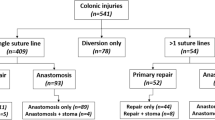Abstract
Background and Aims:
We aimed to evaluate the independent factors of the treatment of penetrating colon injuries in a teaching and research hospital in light of some of the most commonly cited considerations affecting the decision as to whether to perform primary repair or divert.
Methods:
Hospital records of patients between January 2004 and January 2007 were reviewed retrospectively. Fifty-seven patients were included and divided into two groups. Group A consisted of patients (n = 43) who had primary repair or resection and anastomosis, and Group B consisted of patients (n = 14) who had diverting colostomy. The degree of fecal contamination was assessed by reviewing the detailed operative dictation. The type of colon injury, as determined from the colon injury scale (CIS) of the American Association for the Surgery of Trauma (AAST), and the penetrating abdominal trauma index (PATI) were recorded.
Results:
Age, sex, presence of shock on admission, location of the injury, and colon-related or non-colonrelated complications between the two groups were not significant. Stab or gunshot injury, operation time, degree of fecal contamination (grade 1/2/3), transfusion, PATI score, hospital stay, and associated organ injury were significantly different in the two groups (p < 0.05).
Conclusion:
Despite the fact that CIS, fecal contamination, transfusion, PATI and delayed operation affect the decision about the procedure, primary repair can be performed safely on patients with penetrating colon injuries.
Similar content being viewed by others
References
Moore EE, Cogbill TH, Malangoni MA, Jurkovich GJ, Champion HR, Gennarelli TA, McAninch JW, Pachter HL, Shackford SR, Trafton PG. Organ injury scaling. II: Pancreas, duedonum, small bowel, colon and rectum. J Trauma 1990;30:1427–31.
Stone HH, Fabian TC. Management of perforating colon trauma randomization between primary closure and extriorization. Ann Surg 1979;190:430–6.
Flint LM, Vitale GC, Richardson JD, Polk HC Jr. The injured colon: relationships of management to complications. Ann Surg 1981;193:619–23.
Hunt KE, Garrison RN, Fry DE. Perforating injuries of the gastrointestinal tract following blunt abdominal trauma. Am Surg 1980;46:100–4.
Curan TJ, Borzotta AP. Complication of primary repair of colon injuries: literature review of 2964 cases. Am J Surg 1999;177:42–7.
George SM Jr, Fabian TC, Voeller GR, Kudsk KA, Mangiante EC, Britt LG. Primary repair of colon wounds. A prospective trial in nonselected patients. Ann Surg 1989;209:728.
Chappulis CW, Frey DJ, Dietzen CD, Panetta TP, Buechter KJ, Cohn I. Management of penetrating colon injuries. A prospective randomized trial. Ann Surg 1991;213:492–7.
Demetriades D, Charalambides D, Pantanowitz D. Gunshot wounds of the colon: role of primary repair. Ann R Coll Surg Engl 1992;74:381–4.
Demetriades D, Murray JA, Chan L, Ordonez C, Bowley D, Nagy KK, Cornwell EE III, Velmahos GC, Munoz N, Hatzitheofilou C, Schwab CW, Rodriguez A, Cornejo C, Davis KA, Namias N, Wisner DH, Ivatury RR, Moore EE, Acosta JA, Maull KI, Thomason MH, Spain DA. Committee on Multicenter Clinical Trials American Association for the Surgery of Trauma Penetrating colon injuries requiring resection: diversion or primary anastomosis? An AAST prospective multicenter study. J Trauma 2001;50:765–75.
Cornwell EE III, Velmahos GC, Berne TV, Murray JA, Chahwan S, Asensio J, Demetriades D. The fate of colonic suture lines in high-risk trauma patients: a prospective analysis. J Am Coll Surg 1998;187:58–63.
Demetriades D. Colon injuries: new perspectives. Injury 2004;35:217–22.
Sasaki LS, Allaben R, Golwala R, Mittal VK. Primary repair of colon injuries: a prospective randomized study. J Trauma 1995;39:895–901.
Gonzalez RP, Merlotti GJ, Holevar MR. Colostomy in penetrating colon injuries: is it necessary. J Trauma 1996;41:271–5.
Ricciardi R, Paterson CA, Islam S, Sweeney WB, Baker SP, Counihan TC. Independent predictors of morbidity and mortality in blunt colon trauma. Am Surg 2004;70:75–9.
Nelson R, Singer M. Primary repair for penetrating colon injuries. Cochrane Database Syst Rev 2003:CD002247.
Fealk M, Osipov R, Foster K, Caruso D, Kassir A. The conundrum of traumatic colon injury. Am J Surg 2004;188:663–70.
Woo K, Wilson MT, Killen K, Margulies DR. Adapting of the changing paradigm of management of colon injuries. Am J Surg 2007;194:746–50.
Cleary RK, Pomerantz RA, Lampman RM. Colon and rectal injuries. Dis Colon Rectum 2006;48:1203–22.
Author information
Authors and Affiliations
Corresponding author
Rights and permissions
About this article
Cite this article
Gür, A.S., Atahan, K., Tarcan, E. et al. Independent Predictors of Treatment Modality for Penetrating Colon Injury. Eur J Trauma Emerg Surg 35, 378–382 (2009). https://doi.org/10.1007/s00068-008-8116-7
Received:
Accepted:
Published:
Issue Date:
DOI: https://doi.org/10.1007/s00068-008-8116-7




